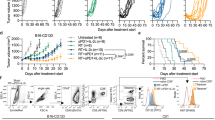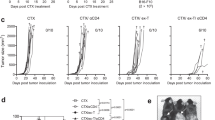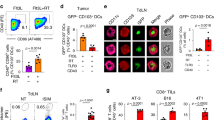Abstract
Using a model of established malignancy, we found that cyclophosphamide (Cy), administered at a dose not requiring hematopoietic stem cell support, is superior to low-dose total body irradiation in augmenting antitumor immunity. We observed that Cy administration resulted in expansion of tumor antigen-specific T cells and transient depletion of CD4+Foxp3+ regulatory T cells (Tregs). The antitumor efficacy of Cy was not improved by administration of anti-CD25 monoclonal antibody given to induce more profound Treg depletion. We found that Cy, through its myelosuppressive action, induced rebound myelopoiesis and perturbed dendritic cell (DC) homeostasis. The resulting DC turnover led to the emergence of tumor-infiltrating DCs that secreted more IL-12 and less IL-10 compared to those from untreated tumor-bearing animals. These newly recruited DCs, originating from proliferating early DC progenitors, were fully capable of priming T cell responses and ineffective in inducing expansion of Tregs. Together, our results show that Cy-mediated antitumor effects extend beyond the well-documented cytotoxicity and lymphodepletion and include resetting the DC homeostasis, thus providing an excellent platform for integration with other immunotherapeutic strategies.





Similar content being viewed by others
References
Lake RA, Robinson BW (2005) Immunotherapy and chemotherapy—a practical partnership. Nat Rev Cancer 5:397–405
Zitvogel L, Apetoh L, Ghiringhelli F, Andre F, Tesniere A et al (2008) The anticancer immune response: indispensable for therapeutic success? J Clin Invest 118:1991–2001
Nowak AK, Lake RA, Robinson BWS (2006) Combined chemoimmunotherapy of solid tumours: improving vaccines? Adv Drug Deliv Rev 58:975
Obeid M, Tesniere A, Ghiringhelli F, Fimia GM, Apetoh L et al (2007) Calreticulin exposure dictates the immunogenicity of cancer cell death. Nat Med 13:54–61
Gattinoni L, Finkelstein SE, Klebanoff CA, Antony PA, Palmer DC et al (2005) Removal of homeostatic cytokine sinks by lymphodepletion enhances the efficacy of adoptively transferred tumor-specific CD8+ T cells. J Exp Med 202:907–912
Dummer W, Niethammer AG, Baccala R, Lawson BR, Wagner N et al (2002) T cell homeostatic proliferation elicits effective antitumor autoimmunity. J Clin Invest 110:185–192
Ercolini AM, Ladle BH, Manning EA, Pfannenstiel LW, Armstrong TD et al (2005) Recruitment of latent pools of high-avidity CD8(+) T cells to the antitumor immune response. J Exp Med 201:1591–1602
North RJ (1982) Cyclophosphamide-facilitated adoptive immunotherapy of an established tumor depends on elimination of tumor-induced suppressor T cells. J Exp Med 155:1063–1074
Ghiringhelli F, Larmonier N, Schmitt E, Parcellier A, Cathelin D et al (2004) CD4+CD25+ regulatory T cells suppress tumor immunity but are sensitive to cyclophosphamide which allows immunotherapy of established tumors to be curative. Eur J Immunol 34:336–344
Zhang B, Bowerman NA, Salama JK, Schmidt H, Spiotto MT et al (2007) Induced sensitization of tumor stroma leads to eradication of established cancer by T cells. J Exp Med 204:49–55
Paulos CM, Wrzesinski C, Kaiser A, Hinrichs CS, Chieppa M et al (2007) Microbial translocation augments the function of adoptively transferred self/tumor-specific CD8+ T cells via TLR4 signaling. J Clin Invest 117:2197–2204
Wrzesinski C, Paulos CM, Gattinoni L, Palmer DC, Kaiser A et al (2007) Hematopoietic stem cells promote the expansion and function of adoptively transferred antitumor CD8 T cells. J Clin Invest 117:492–501
Dudley ME, Yang JC, Sherry R, Hughes MS, Royal R et al (2008) Adoptive cell therapy for patients with metastatic melanoma: evaluation of intensive myeloablative chemoradiation preparative regimens. J Clin Oncol 26:5233–5239
Jones RJ, Barber JP, Vala MS, Collector MI, Kaufmann SH et al (1995) Assessment of aldehyde dehydrogenase in viable cells. Blood 85:2742–2746
Moyo VM, Smith D, Brodsky I, Crilley P, Jones RJ et al (2002) High-dose cyclophosphamide for refractory autoimmune hemolytic anemia. Blood 100:704–706
Salem ML, Kadima AN, El-Naggar SA, Rubinstein MP, Chen Y et al (2007) Defining the ability of cyclophosphamide preconditioning to enhance the antigen-specific CD8+ T-cell response to peptide vaccination: creation of a beneficial host microenvironment involving type I IFNs and myeloid cells. J Immunother 30:40–53
Lutsiak ME, Semnani RT, De Pascalis R, Kashmiri SV, Schlom J et al (2005) Inhibition of CD4(+)25(+) T regulatory cell function implicated in enhanced immune response by low-dose cyclophosphamide. Blood 105:2862–2868
Ibe S, Qin Z, Schuler T, Preiss S, Blankenstein T (2001) Tumor rejection by disturbing tumor stroma cell interactions. J Exp Med 194:1549–1560
Schiavoni G, Mattei F, Di Pucchio T, Santini SM, Bracci L et al (2000) Cyclophosphamide induces type I interferon and augments the number of CD44(hi) T lymphocytes in mice: implications for strategies of chemoimmunotherapy of cancer. Blood 95:2024–2030
Angulo I, de las Heras FG, Garcia-Bustos JF, Gargallo D, Munoz-Fernandez MA et al (2000) Nitric oxide-producing CD11b(+)Ly-6G(Gr-1)(+)CD31(ER-MP12)(+) cells in the spleen of cyclophosphamide-treated mice: implications for T-cell responses in immunosuppressed mice. Blood 95:212–220
Pelaez B, Campillo JA, Lopez-Asenjo JA, Subiza JL (2001) Cyclophosphamide induces the development of early myeloid cells suppressing tumor cell growth by a nitric oxide-dependent mechanism. J Immunol 166:6608–6615
Luznik L, Slansky JE, Jalla S, Borrello I, Levitsky HI et al (2003) Successful therapy of metastatic cancer using tumor vaccines in mixed allogeneic bone marrow chimeras. Blood 101:1645–1652
Jain A, Slansky JE, Matey LC, Allen HE, Pardoll DM et al (2003) Synergistic effect of a granulocyte-macrophage colony-stimulating factor-transduced tumor vaccine and systemic interleukin-2 in the treatment of murine colorectal cancer hepatic metastases. Ann Surg Oncol 10:810–820
Tacke F, Ginhoux F, Jakubzick C, van Rooijen N, Merad M et al (2006) Immature monocytes acquire antigens from other cells in the bone marrow and present them to T cells after maturing in the periphery. J Exp Med 203:583–597
Marino JH, Cook P, Miller KS (2003) Accurate and statistically verified quantification of relative mRNA abundances using SYBR Green I and real-time RT-PCR. J Immunol Methods 283:291–306
Rizzitelli A, Berthier R, Collin V, Candeias SM, Marche PN (2002) T lymphocytes potentiate murine dendritic cells to produce IL-12. J Immunol 169:4237–4245
Kitazawa M, Oddo S, Yamasaki TR, Green KN, LaFerla FM (2005) Lipopolysaccharide-induced inflammation exacerbates tau pathology by a cyclin-dependent kinase 5-mediated pathway in a transgenic model of Alzheimer’s disease. J Neurosci 25:8843–8853
Overbergh L, Giulietti A, Valckx D, Decallonne R, Bouillon R et al (2003) The use of real-time reverse transcriptase PCR for the quantification of cytokine gene expression. J Biomol Tech 14:33–43
Mitrasinovic OM, Perez GV, Zhao F, Lee YL, Poon C et al (2001) Overexpression of macrophage colony-stimulating factor receptor on microglial cells induces an inflammatory response. J Biol Chem 276:30142–30149
Machiels JP, Reilly RT, Emens LA, Ercolini AM, Lei RY et al (2001) Cyclophosphamide, doxorubicin, and paclitaxel enhance the antitumor immune response of granulocyte/macrophage-colony stimulating factor-secreting whole-cell vaccines in HER-2/neu tolerized mice. Cancer Res 61:3689–3697
Onizuka S, Tawara I, Shimizu J, Sakaguchi S, Fujita T et al (1999) Tumor rejection by in vivo administration of anti-CD25 (interleukin-2 receptor alpha) monoclonal antibody. Cancer Res 59:3128–3133
Huang AY, Gulden PH, Woods AS, Thomas MC, Tong CD et al (1996) The immunodominant major histocompatibility complex class I-restricted antigen of a murine colon tumor derives from an endogenous retroviral gene product. Proc Natl Acad Sci USA 93:9730–9735
Nguyen LT, Elford AR, Murakami K, Garza KM, Schoenberger SP et al (2002) Tumor growth enhances cross-presentation leading to limited T cell activation without tolerance. J Exp Med 195:423–435
Tang Q, Adams JY, Penaranda C, Melli K, Piaggio E et al (2008) Central role of defective interleukin-2 production in the triggering of islet autoimmune destruction. Immunity 28:687–697
Gabrilovich D (2004) Mechanisms and functional significance of tumour-induced dendritic-cell defects. Nat Rev Immunol 4:941–952
O’Connell PJ, Morelli AE, Logar AJ, Thomson AW (2000) Phenotypic and functional characterization of mouse hepatic CD8{alpha}+ lymphoid-related dendritic cells. J Immunol 165:795–803
Shortman K, Liu YJ (2002) Mouse and human dendritic cell subtypes. Nat Rev Immunol 2:151–161
Pillarisetty VG, Shah AB, Miller G, Bleier JI, DeMatteo RP (2004) Liver dendritic cells are less immunogenic than spleen dendritic cells because of differences in subtype composition. J Immunol 172:1009–1017
del Hoyo GM, Martin P, Vargas HH, Ruiz S, Arias CF et al (2002) Characterization of a common precursor population for dendritic cells. Nature 415:1043
Waskow C, Liu K, Darrasse-Jeze G, Guermonprez P, Ginhoux F et al (2008) The receptor tyrosine kinase Flt3 is required for dendritic cell development in peripheral lymphoid tissues. Nat Immunol 9:676–683
Naik SH (2008) Demystifying the development of dendritic cell subtypes, a little. Immunol Cell Biol 86:439–452
Sefc L, Psenak O, Sykora V, Sulc K, Necas E (2003) Response of hematopoiesis to cyclophosphamide follows highly specific patterns in bone marrow and spleen. J Hematother Stem Cell Res 12:47–61
Varol C, Landsman L, Fogg DK, Greenshtein L, Gildor B et al (2007) Monocytes give rise to mucosal, but not splenic, conventional dendritic cells. J Exp Med 204:171–180
Drakes ML, Zahorchak AF, Takayama T, Lu L, Thomson AW (2000) Chemokine and chemokine receptor expression by liver-derived dendritic cells: MIP-1alpha production is induced by bacterial lipopolysaccharide and interaction with allogeneic T cells. Transpl Immunol 8:17–29
Lu B, Rutledge BJ, Gu L, Fiorillo J, Lukacs NW et al (1998) Abnormalities in monocyte recruitment and cytokine expression in monocyte chemoattractant protein 1-deficient mice. J Exp Med 187:601–608
Yoneyama H, Matsuno K, Zhang Y, Murai M, Itakura M et al (2001) Regulation by chemokines of circulating dendritic cell precursors, and the formation of portal tract-associated lymphoid tissue, in a granulomatous liver disease. J Exp Med 193:35–49
Zhang Y, Yoneyama H, Wang Y, Ishikawa S, Hashimoto S-I et al (2004) Mobilization of dendritic cell precursors into the circulation by administration of MIP-1{alpha} in mice. J Natl Cancer Inst 96:201–209
Onai N, Obata-Onai A, Schmid MA, Ohteki T, Jarrossay D et al (2007) Identification of clonogenic common Flt3+M-CSFR+ plasmacytoid and conventional dendritic cell progenitors in mouse bone marrow. Nat Immunol 8:1207–1216
Liu K, Victora GD, Schwickert TA, Guermonprez P, Meredith MM et al (2009) In vivo analysis of dendritic cell development and homeostasis. Science 324:392–397
Auffray C, Fogg DK, Narni-Mancinelli E, Senechal B, Trouillet C et al (2009) CX3CR1+ CD115+ CD135+ common macrophage/DC precursors and the role of CX3CR1 in their response to inflammation. J Exp Med 206:595–606
Ghiringhelli F, Puig PE, Roux S, Parcellier A, Schmitt E et al (2005) Tumor cells convert immature myeloid dendritic cells into TGF-{beta}-secreting cells inducing CD4+CD25+ regulatory T cell proliferation. J Exp Med 202:919–929
Vicari AP, Chiodoni C, Vaure C, Ait-Yahia S, Dercamp C et al (2002) Reversal of tumor-induced dendritic cell paralysis by CpG immunostimulatory oligonucleotide and anti-interleukin 10 receptor antibody. J Exp Med 196:541–549
Elpek KG, Lacelle C, Singh NP, Yolcu ES, Shirwan H (2007) CD4+CD25+ T regulatory cells dominate multiple immune evasion mechanisms in early but not late phases of tumor development in a B cell lymphoma model. J Immunol 178:6840–6848
Quezada SA, Peggs KS, Simpson TR, Shen Y, Littman DR et al (2008) Limited tumor infiltration by activated T effector cells restricts the therapeutic activity of regulatory T cell depletion against established melanoma. J Exp Med 205:2125–2138
van der Most RG, Currie AJ, Mahendran S, Prosser A, Darabi A, et al (2009) Tumor eradication after cyclophosphamide depends on concurrent depletion of regulatory T cells: a role for cycling TNFR2-expressing effector-suppressor T cells in limiting effective chemotherapy. Cancer Immunol Immunother 58(8):1219–1228
Dannull J, Su Z, Rizzieri D, Yang BK, Coleman D et al (2005) Enhancement of vaccine-mediated antitumor immunity in cancer patients after depletion of regulatory T cells. J Clin Invest 115:3623–3633
Powell DJ Jr, Felipe-Silva A, Merino MJ, Ahmadzadeh M, Allen T et al (2007) Administration of a CD25-directed immunotoxin, LMB-2, to patients with metastatic melanoma induces a selective partial reduction in regulatory T cells in vivo. J Immunol 179:4919–4928
Mende I, Engleman EG (2007) Breaking self-tolerance to tumor-associated antigens by in vivo manipulation of dendritic cells. Methods Mol Biol 380:457–468
Author information
Authors and Affiliations
Corresponding author
Electronic supplementary material
Below is the link to the electronic supplementary material.
Rights and permissions
About this article
Cite this article
Radojcic, V., Bezak, K.B., Skarica, M. et al. Cyclophosphamide resets dendritic cell homeostasis and enhances antitumor immunity through effects that extend beyond regulatory T cell elimination. Cancer Immunol Immunother 59, 137–148 (2010). https://doi.org/10.1007/s00262-009-0734-3
Received:
Accepted:
Published:
Issue Date:
DOI: https://doi.org/10.1007/s00262-009-0734-3




